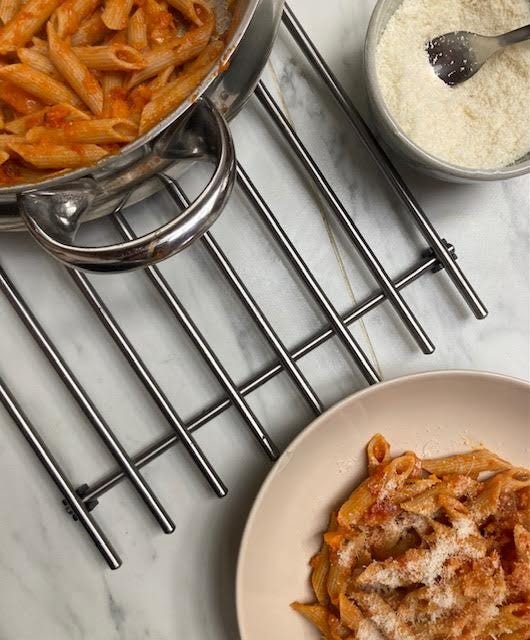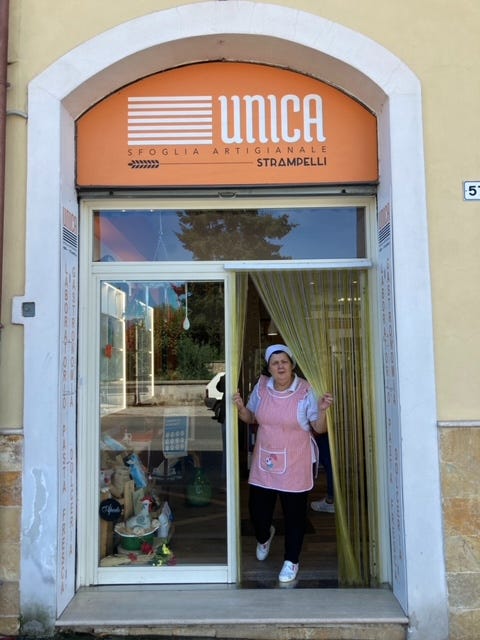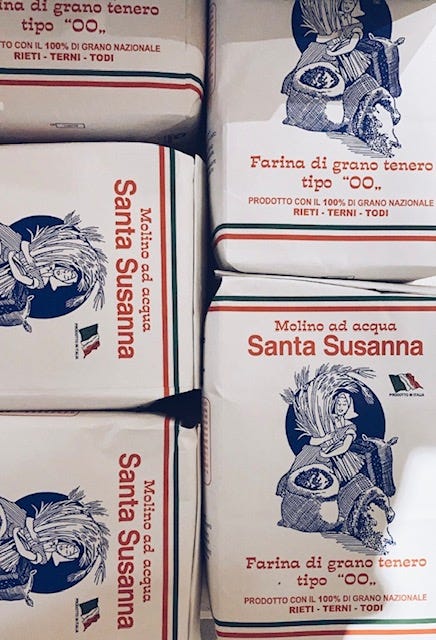In Praise of Pasta Secca. Dry Pasta. Story and Its New Shape. Part I
A recipe for Pasta with Pumpkin Sauce.
Our first kitchen was on via Cleonia in Monteverde Vecchio, and when Riccardo went on a business trip overnight to Torino, I put on the cheap white cotton sundress that I had purchased at a stall for these types of situations, filled the sink with hot soapy water and used a scrub brush to remove the black Roman smog from the walls. It was retro, it was functional, and even though the fluorescent light over the kitchen table made you feel like you had committed a crime, the kitchen was now sparkling, and it was mine.
And in the autumn of this kitchen, I learned and continued to accidentally create and discover many things, one of them being this pumpkin sauce which I tossed with some ‘pasta corta’ on a typically warm October afternoon. It is still something that I make every year as we enjoy it so much, but it never seems to taste as good as it did the first time. And does it ever? I did not think to write down the exact recipe which still annoys me to this day.
The main star of this recipe was a type of ‘zucca gialla’, in the form of a French fairytale pumpkin known as la zucca Moscata di Provenza. With its sweet and creamy flavour, it is easily spotted in Italian markets, cut open in a reassuring way to expose and seduce with its bright orange pulp.
I still remember leaning over the gas stove to render the fat of the pancetta, to watch the thinly sliced onion turn clear and the turn of the white lid on the fresh jar of tomatoes that we recently canned. That bright orange flesh melting into it all, the deepening colour of the sauce with its little oil slick rising, and the perfume of rosemary on the tips of my fingers. All of this I remember. These days guanciale tends to replace pancetta and Pecorino Romano cuts into or is replaced by Parmigiano, but any mixture of these ingredients makes for a great dish. For those who don’t prefer the Godly taste of the pig, especially his cheek, you can replace the rendered fat with a thin layer of extra virgin olive oil to coat the bottom of the pan and continue from there.
The pasta, after about 6 months of discovering my celiac disease, was of course gluten free and most likely a corn/rice hybrid type which was, and still is, readily available in supermarkets and chemists across the boot. The 2020 annual report on celiac disease presented by the Italian minister of health shows us that 233,147 individuals registered with celiac disease, of which I am one, spent €209.688.912,20 on gluten free products and this is only what is recorded. It is mind boggling to think of the additional expenditure on behalf of non-celiac disease sufferers who rest on the spectrum between gluten intolerance and wheat allergy. This also does not include the spending of individuals on the entire spectrum who travel to Italy in the millions with their combined culinary desires and dining decisions.
The shape of gluten free pasta has changed since that afternoon 13 years ago, with the market now offering endless shapes, textures and colours in categories of pasta fresca typically made with soft wheat and the pasta secca which is typically composed of durum wheat. Italy’s industrial pasta giant De Cecco now joins other companies, both big and small in producing gluten free pasta that is made with combinations of pseudograins and pulses such as corn, rice, peas, potato starch, buckwheat, chickpeas, quinoa, amaranth, millet, sorghum, teff and lentils. De Cecco also dedicates a website page to these products asking ‘Why Do So Many People Have Difficulty In Digesting Gluten?’ With the answer, ‘Although intolerance is often due to hereditary factors, its causes could also be due to the immune system, infectious diseases or nutrition. In any case, one intolerance is not the same as the other. There are generally three clinical pictures: celiac disease, wheat allergy and sensitivity to gluten and/or wheat. And for a number of reasons, I am very impressed.
These companies are now responding to the buying power of this growing population, and are also appealing to the mainstream consumer to offer a MADE IN ITALY product that is nutritious, flexible and convenient with whole food ingredients that aim to support a domestic, sustainable and sovereign food system. These changes also satiate the desires of a growing market of health and climate conscious plant-based consumers.
A few months ago @elizabethsimari, University Instructor of courses on Italian food & wine, and culinary tour guide based in Rome commented on one of my Instagram posts, and at the risk of misquoting her in a timely search to find the comment, she reminded us that it is no longer sustainable to produce pasta exclusively with wheat, and with that one comment, I asked myself, ‘when is the last time that it was?’.
From January to November 2021, Italy imported 122,000 tons of soft wheat (zero of durum wheat) from Ukraine and 72,000 tons from Russia (51,000 of durum wheat), according to national statistics data (ISTAT) processed by agricultural research firm, Confagricoltura. And it is the recent conflict of these two nations that has reconfirmed the fragility of our mostly non-existent local food security.
Italy, the world’s frontline in food, has recently appointed a new Minister of Agriculture, changing the title to the Minister of Agriculture and Food Sovereignty as the country aims to reduce their dependence on foreign countries and to solidify their commitment to a system that provides a link between food, agriculture, cultures and ecosystems. Formally embracing the three environmental, social and economic pillars of sustainability, the scope is to offer Italians a supply of high quality national food products.
With Italians consuming between 50 and 60 pounds of pasta a year, not to mention the average consumption around the world, it is hard to discuss food sovereignty in Italy without addressing ‘cereal sovereignty’ which also helps to strengthen local food systems and public health. Upon opening my social media yesterday morning, I spotted Ernesto Di Renzo anthropologist and professor at the University of Rome Tor Vergata, speaking about pseudograins as part of @cerealiafestival where they examined their integration into the path of sustainable agricultural models.
Both Italian industrial pasta giants and small artisan producers are now paving a new path in the pasta world. Pasta d'Alba an organic artisan pasta company in the heart of the Langhe, makes regular and gluten free handmade pasta using organic flours, whole grains, ancient grains and legumes and these small producers are on the rise both in Italy and in communities that house the world’s pasta lovers. Pastaio Via Corta, is a fresh organic homemade pasta, provisions & natural wine shop founded by Danielle Glantz is located in Downtown Gloucester, Massachusetts. They create pasta that is made from non-gmo wheat that is certified organic, stone milled and sustainably grown in the North East.
This is the future of good pasta and we all have the power to change its shape.
PASTA AL SUGO DI ZUCCA
Serves 4
Ingredients:
400g of short pasta, GF if necessary
300g of pumpkin roughly chopped
100g guanciale or pancetta diced or cut into small batons
1 400g tin of high-quality plum tomatoes
1 small white onion thinly sliced
A splash of dry white wine
A small sprig of rosemary, needles finely chopped
Sea salt and freshly ground black pepper
1/2 small pepperoncino, optional
Extra virgin olive oil, optional
Finely grated Parmigiano Reggiano and/or Pecorino Romano to serve
Method:
Boil a large pot of salted water and add your pasta when you are over halfway into cooking your sauce which will take about 30 minutes.
Add your meat or a thin film of olive oil to a medium, wide, heavy bottomed pan big enough to hold the cooked pasta. Turn the hob on to a medium low heat and cook until the fat is rendered and the meat is starting to crisp. Add the white wine and when it evaporates, remove the meat with a slotted spoon, set aside and keep warm. Add your onion, rosemary and peperoncino to the fat or olive oil, stir and cook the onions on low heat until they are translucent. Add your tin of tomatoes, crushing with the back of a wooden spoon, then add your pumpkin. Season and then cover the pan and cook on low for about 10/15 minutes. Uncover and gently crush the pumpkin with the back of the same spoon and continue cooking. Add some cooking water to loosen the sauce if necessary. Return the meat to the sauce and continue cooking for another few minutes and then check the seasoning again. Drain the pasta when al dente and make sure to save another bit of cooking water if necessary. Add the pasta to the sauce, toss gently and serve with the grated cheese.
Notes: 1. I use a whole grain gluten free pasta here, and usually prefer penne or mezze maniche. 2. Choose a bright orange pumpkin or squash that will melt into your sauce. I have met some uncooperative Cucurbita, and without ‘the melt’ the dish isn’t the same.







